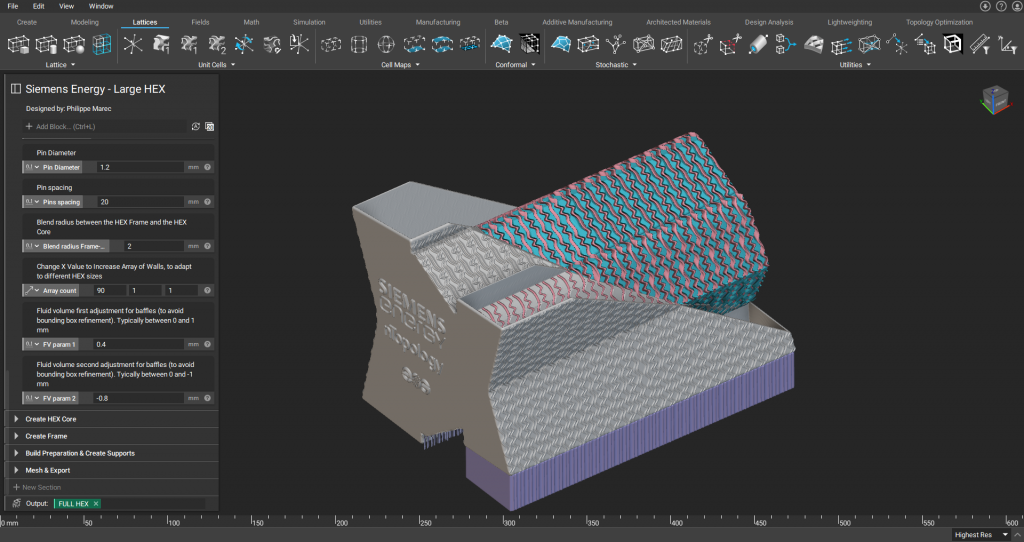Famously, in 3D printing, when it comes to the design and production of complex geometries, “complexity is free.” I’ve always taken this phrase to mean “3D printing comes with a lot of problems,” while others insist that it means that “we can batch manufacture super complicated shapes for the same prices as we can batch manufacture simple ones.” Additive manufacturing (AM)’s ability to make lots of unique, optimally designed geometries has lead to an explosion in the complexity of AM parts. Highly engineered components can feature a great deal of lattices, internal chambers, special textures, and many architected surfaces. Keeping pace, the resulting files have exploded in size as well. This leads to poor handling on even very fast computers, as well as the usage of a lot of storage space. With color, gradient parts, material mixing, and more we can only imagine how complex and huge the files of the future will be.
EOS and nTopology have collaborated on an answer to the huge, unwieldy file problem. The potential solution is called “Implicit Interop.” This may sound like an interagency Taskforce on healthcare fraud, but in reality it is a Weight Watchers program for your files. According to the companies, Interop could reduce file sizes by 99% and load files 60% quicker, leading to files being generated 500 times faster. EOSPRINT 2.14 will feature an Implicit Interop plugin starting in June 2023.
In addition to the time saved, Implicit Interop maintains the fidelity and design intent of the original file. This is possible because it skips the mesh creation and rendering steps, which could take minutes, hours, or days depending on how complicated the file is. Instead the team transfers and keeps the data in an implicit modeling file. Now, they want to make these types of files easy to exchange between software programs, hence the Implicit Interop moniker.

his industrial heat exchanger was designed by Siemens Energy in nTopology. The design was previously unmanufacturable due to the limitations of the current data transfer formats.
As an example the duo previously showcased a Siemens Energy heat exchanger, described in just a 1 MB file, making it much quicker to import into EOSPRINT. EOS and nTopology also want to standardize the Implicit File format via the 3MF Consortium.
“nTopology has opened up design freedom and enabled engineers to design products that they weren’t able to do before. This has led to even more complex designs that have led them to uncover design data bottlenecks in printing those designs. With our focus on being a useful tool for engineers – to not just design but produce these parts – we worked with EOS to come up with a solution to enable these complex parts to be printed. We look forward to advancing the entire industry based on this type of partnership with OEMs,” said nTopology CEO, Bradley Rothenberg,
“With modern design approaches such as topology optimization, generative design, and DfAM on the rise, the complexity of part geometries has been skyrocketing. Discretization of such complex models often results in meshes with file sizes greater than several gigabytes which can make them very challenging to handle in later production steps,” said Alexander Bockstaller, Software Product Line Manager at EOS. “EOS tackles the problem and drives the standardization of implicit geometry representation, which makes it possible to build designs that were previously unbuildable.”

Section cut of the heat exchanger design in nTopology. The pathways for the hot and cold fluid domains in the heat exchanger core are visible.
Now, I worry that this tool will really lead to a huge reduction in spontaneous smoke breaks and idle chitchat between colleagues. I also believe that this will result, in the long run, in knowing significantly less about key matters such as the Minnesota Vikings, the accomplishments of various children, where to holiday in Greece, the relative merits of midsized trucks and Netflix shows. On the other hand, it will be a significant productivity increase for the industry. There are too few people in the sector already and, now, they will work more and wait less.
Seriously, though, I love this approach. Implicit Interop could really save our industry many thousands of hours. I also like that they’re trying to standardize this. Maybe becoming the PDF interchange format will finally embed implicit modeling tools in everyone’s workflow. Now, nTop software is seen as cool but difficult, a niche tool that could change everything. Perhaps, via file exchange, the industry can nibble on nTopology slowly and then get drawn into a more implicit world.
Subscribe to Our Email Newsletter
Stay up-to-date on all the latest news from the 3D printing industry and receive information and offers from third party vendors.
Print Services
Upload your 3D Models and get them printed quickly and efficiently.
You May Also Like
Consolidation in AM: How 2025 Is Shaping the Industry’s New Normal
The first half of 2025 has been marked by a clear shift in the additive manufacturing (AM) industry. Companies are no longer just focused on developing new tech by themselves....
Etsy Design Rule Change Reduces Selection of 3D Printed Goods
Online marketplace Etsy has implemented a rule change requiring all 3D printed goods on the site to be original designs. The update to the site’s Creativity Standards states, ¨Items produced using...
U.S. Congress Calls Out 3D Printing in Proposal for Commercial Reserve Manufacturing Network
Last week, the U.S. House of Representatives’ Appropriations Committee moved the FY 2026 defense bill forward to the House floor. Included in the legislation is a $131 million proposal for...
Transforming From Tourist to Native: Duro CEO Michael Corr Explains Why the Company Rebuilt its PLM Software on AI
In these early innings of the AI boom, many market analysts have expressed concern that AI spend has gotten too far ahead of the technology’s proven ability to deliver significant...
































